Crowns vs veneers for front teeth: Which is best for you?
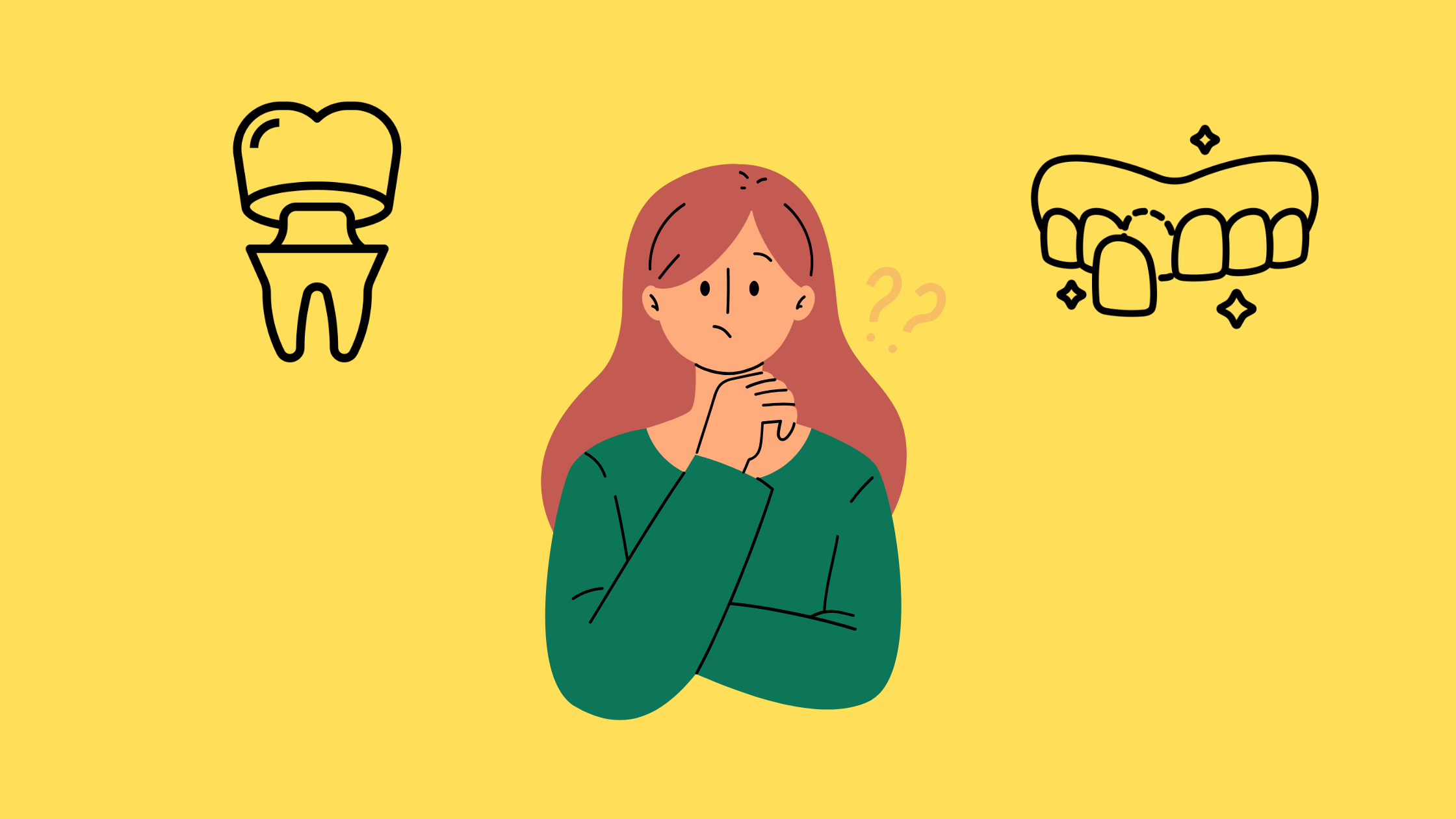 If you're unhappy with the appearance of your front teeth, you may be considering cosmetic dental treatments such as crowns or veneers. But which option is the best fit for you?
If you're unhappy with the appearance of your front teeth, you may be considering cosmetic dental treatments such as crowns or veneers. But which option is the best fit for you?
While both treatments can improve the look of your smile, they have different benefits and drawbacks.
In this article, we will compare crowns and veneers and explain their most common indications to help you make an informed decision about which option is best for you.
Key takeaways:
- Veneers are a conservative and minimally invasive option to restore the appearance of healthy or slightly damaged front teeth, whereas crowns are typically recommended for more severe cases where the teeth are extensively damaged or weakened.
- Veneers can address a variety of cosmetic issues, such as discoloration, minor fractures, misshapen or asymmetrical teeth, minor crowding, and gaps between teeth.
- Crowns and veneers for front teeth are typically made of porcelain or other ceramic materials, which can mimic the natural appearance and properties of our teeth.
- The lifespan of veneers and crowns depends on various factors, including oral hygiene practices, diet, and general wear and tear. Proper care and maintenance can help prolong their lifespan and preserve their appearance.
Crowns and veneers: The key difference when it comes to restoring front teeth:
When a tooth needs restoration, we always consider the most gentle and conservative option first. For instance, if your tooth is discolored due to coffee stains, we would prefer to try whitening first before opting for more invasive procedures like a crown or veneer. This approach helps to preserve as much of the natural tooth structure as possible.If you have damaged front teeth or want to enhance their appearance, veneers are usually the first option to consider. Veneers are thin shells that cover only the front of the teeth and require minimal preparation, which means we only need to remove a small amount of tooth enamel (as the image below shows).
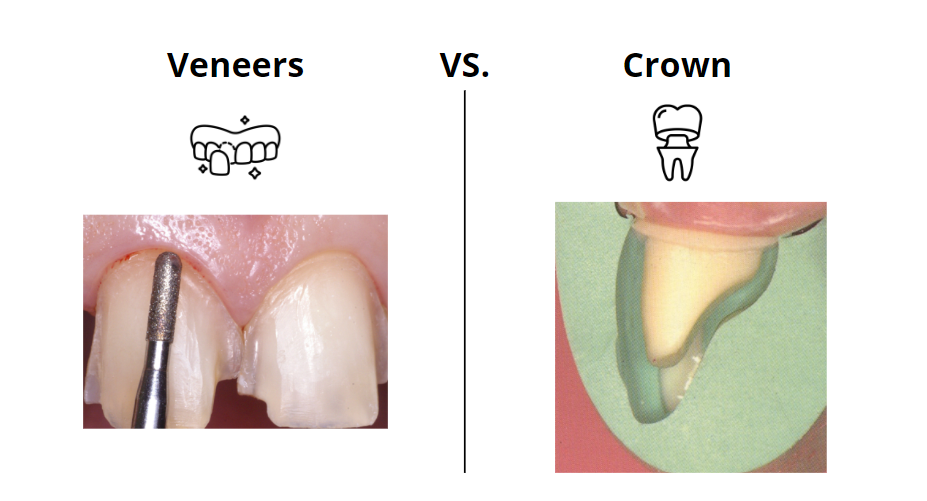
On the other hand, crowns are caps that cover the entire visible part of the teeth and require more extensive preparation, which involves removing more of the tooth structure to fit the crown properly.
You might consider crowns if your teeth are severely damaged by decay or trauma. In these situations, veneers may not be an option as they require the tooth to be relatively healthy for them to attach firmly and durably.
Overall, if you want to improve the appearance of your healthy front teeth, veneers might be the option you are looking for. But if your teeth are weakened or damaged, a crown may be needed to provide extra support and protection.
The most common situations where you may need veneers:
The primary purpose of veneers is almost always aesthetic. You may want veneers to address a minor problem on your front teeth to achieve an even brighter smile. However, remember that the tooth must be initially healthy (or only slightly damaged). Otherwise, you may want to switch to crowns for a more cosmetic and long-lasting solution.When you choose veneers, you will usually get many of them (6 to 8) to cover the other healthy teeth you show when you smile. This way, the color of your front teeth will be even, allowing the veneers to blend seamlessly into your mouth.
Here are some situations where veneers can be a good option:
1. Discoloration:
Sometimes tooth discoloration is stubborn and persists despite multiple in-office teeth whitening sessions. This is especially true for discolorations caused by certain medications, genetics, or fluorosis. In this case, veneers can be an excellent alternative to give you a brighter, younger smile. Veneers can cover these stains and create a uniform color on all front teeth.
2. Fracture:
If you have a chipped or cracked front tooth, veneers can be an effective way to restore its appearance. Veneers can cover the damaged area as well as other neighboring teeth for a whiter, brighter look.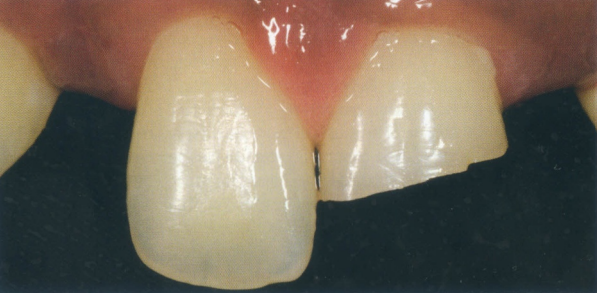
3. Fixing the teeth shape:
If you have a misshapen or asymmetrical front tooth, veneers can also be a great option to create a more balanced, aesthetically pleasing smile.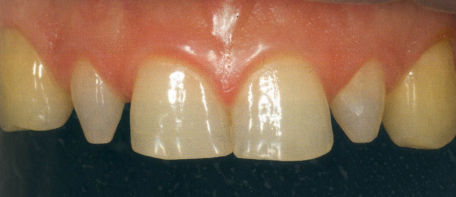
4. Correcting a minor crowding:
If you have slight crowding or spacing issues with your front teeth, veneers can help. They can be used to widen or lengthen teeth or to straighten a slightly shifted tooth to create a more even appearance.5. Closing a diastema or black gaps between the teeth:
If you have black gaps between your front teeth (due to receding gums) or a diastema, veneers can be a great option to close these gaps and create a more even, attractive smile.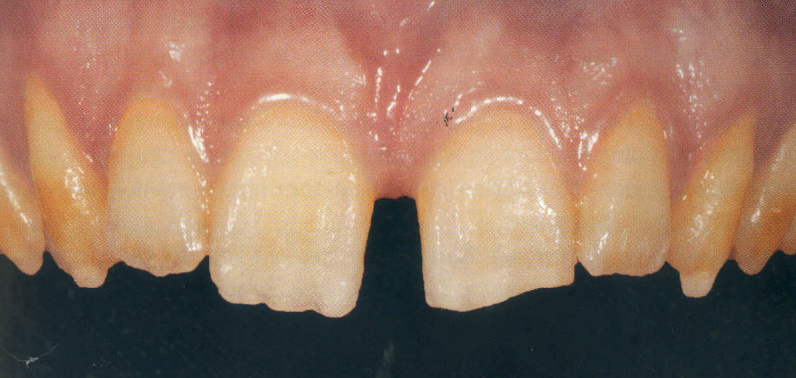
When should I choose crowns over veneers on my front teeth?
Both crowns and veneers can improve the appearance of your front teeth and give them a natural look.However, while veneers can be used on healthy teeth, crowns are typically indicated in more extreme cases where the teeth are too damaged.
For example, dental crowns may be the right option if your teeth are too crowded, severely damaged by decay, or deeply discolored.
If your tooth has a root canal, again a crown is the only solution, as veneers require the tooth to be alive.
If you grind or clench your teeth, veneers cannot be placed because they are more fragile and may break quickly. In this case, crowns would be a more effective and durable solution than veneers.

Examples of situations where dental crowns are needed
The most cosmetic types of crowns and veneers for front teeth:
Whether you choose crowns or veneers, they will both be made of the same ceramic material.Porcelain is often considered the best choice because it can mimic the front teeth' natural appearance and properties, where aesthetics and function are crucial. It is highly customizable, allowing it to be color-matched to surrounding teeth, creating a seamless, natural-looking restoration.
Often, crowns and veneers made of porcelain blend in so well that they go unnoticed by the eye.
Additionally, porcelain is highly stain-resistant, maintaining its natural appearance over time. It is also a biocompatible material, meaning that it is well-tolerated by the body, making it a safe and reliable option for dental restorations.
Its only drawback is it can be fragile and break easily, especially if you grind your teeth.
To address this issue, other types of ceramics have emerged that offer improved resistance while still providing excellent aesthetic results. Two of these are E-max and Zirconia.
- E-max: This ceramic material provides the aesthetic appearance of porcelain with greater strength and durability. It is often used for front teeth because of its natural appearance. It can be customized to match the natural characteristics of the teeth, making it difficult to distinguish the crown or veneer from the surrounding teeth.
- Zirconia: This ceramic material is the strongest and hardest but less aesthetically pleasing than porcelain and e-max. Zirconia restorations are less likely to break or chip and tend to last longer. They are also biocompatible, which means they can be used safely without the risk of allergy or immune reaction.
What to expect in terms of results and lifespan?
When it comes to restoring front teeth, both crowns and veneers can provide excellent results.Whichever option you choose, you can expect immediate positive results and the restoration to blend in perfectly with your natural teeth.
If you're looking to make minor cosmetic changes, like improving the shape or color of your tooth, veneers may be the way to go. They can last anywhere from 7-15 years with proper care and make a big difference in your smile.
If your tooth is more severely damaged or decayed, a crown may be necessary to restore it to its original shape and function. Crowns can last up to 15 years or more with good oral hygiene habits and regular check-ups.
Ultimately, the choice between crowns and veneers will depend on your individual needs and the condition of your teeth. Your dentist will help you determine which option is best for you based on the extent of the damage or cosmetic changes you require.